The War of the Gaedhil with the Gaill
Anonymous
Reviewed by David Maclaine

The War of the Gaedhil with the Gaill is literature in the guise of history. It was written in the early twelfth century, a hundred years after the events it describes, and is a work of propaganda designed to glorify the High King of Ireland Brian Boru (Brian Bóruma in Old Irish). The tale presents him in the context of a long history of Scandinavian invasions and begins with a dense, name-clogged overview of those invasions, heavily slanted toward the Irish. All this serves as prelude to the story of the hero’s youth, his family, his brother’s murder, his rise to become High King, and the culminating battle of Clontarf which sealed his fame. As the narrative approaches its great climax on the battlefield it offers well-crafted scenes that bring to life the various characters, with an especially lively sequence showing how the Irish regional king Maelmordha was goaded into rebellion. The scenes of battle are intense and enjoyable, with skillful shifts of perspective, from the forefront of the battle where Brian’s son Murchadh mows down his adversaries like a Hong Kong action hero, to the battlements of Dublin where a Norse king and his Irish wife trade barbed remarks about the battle’s ebb and flow.
The nineteenth-century editor and translator of the The War of the Gaedhil with the Gaill calls it “inflated and bombastic” and its over-the-top style is silly enough to entertain. The unknown author was way too fond of alliteration - mostly lost in translation - and obsessively spins out strings of synonymous words. But this biased account of the battle between “the bright, fresh, never-weary, terrible, valiant, victorious heroes” and their “untamable, inexorable, unsteady, cruel, barbarous” foes remains one of the most vivid fictional treatments of the great collision between the Norse and Irish worlds. (early 12th century; the Cambridge University Press edition is 586 pages)
More about The War of the Gaedhil with the Gaill at Powell's Books or Amazon.comOther novels which include the Battle of Clontarf:
Njal's Saga (circa 1270 to 1290; author unknown), about a feud between two families in Iceland. More info at Powell's Books or read online at the Icelandic Saga Database
The Kings in Winter by Cecelia Holland (1967), about an Irish clan chief struggling to prevent a feud from breaking out during the months leading up to the Battle of Clontarf. See review or more info at Amazon.com
Odinn's Child by Tim Severin (2005), about a son of Leif Ericson who arrives in Greenland in 1001, is raised as a pagan, and fights against Brian Boru in the Battle of Clontarf; based on the Eyrbyggja Saga; #1 in a trilogy. More info
Nonfiction about the Battle of Clontarf and the High King Brian Boru:
The Battle of Clontarf: Good Friday, 1014 by Darren McGettigan (2013). More info
Brian Boru: King of Ireland by Roger Chatterton Newman (2011). More info
Brian Boru: Ireland's Greatest King? by Maire Ni Mhaonaigh (2006). More info
Online:
Battle of Clontarf at Clontarf.ie, a website sponsored by the Clontarf Residents’ Association and the Clontarf Business Association (Clontarf is now a suburb of Dublin)
Back to Novels of the Medieval Celts
Back to Directory of Book Reviews